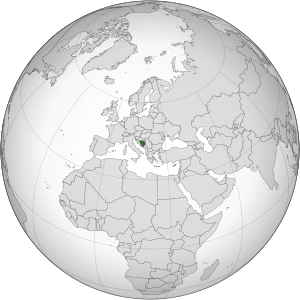More languages
More actions
| Bosnia and Herzegovina Bosna i Hercegovina Босна и Херцеговина | |
|---|---|
 | |
| Capital and largest city | Sarajevo |
| Official languages | Serbo-Croatian |
| Dominant mode of production | Capitalism |
| Leaders | |
• High Representative | Christian Schmidt |
• Chairman of the Presidency | Denis Bećirović |
• Members of the Presidency | Željka Cvijanović Željko Komšić |
| Area | |
• Total | 51,209 km² |
| Population | |
• 2022 estimate | 3,434,000 |
Bosnia and Herzegovina, sometimes shortened to Bosnia, is a country in the Balkans bordered by Serbia, Croatia and Montenegro with a short coast on the Adriatic Sea. It is a de facto colony of the United States and the European Union.[1] The country is split between the Muslim-Croat Federation of Bosnia and the Serb Republic.[2]
History
Austrian Rule
At the Congress of Berlin in 1878 Austria-Hungary was authorized to occupy Bosnia and Hercegovina from the Ottoman Empire, converting the region into an Austrian colony. The Dual Monarchy annexed the territory in October 1908 causing a crisis and prompting an increase in revolutionary feeling among the populace. Bosnia-Hercegovina would remain under Austrian rule until the First World War and the collapse of Austria-Hungary in 1918.[3]
Kingdom of Yugoslavia
After being freed from Austrian rule Bosnia became a part of the Kingdom of Serbs, Croats, and Slovenes, later called Kingdom of Yugoslavia, but failures to solve social and national questions would later cause demonstrations. After the invasion of Yugoslavia in the Second World War, Bosnia became a centre of rebellion in the national liberation struggle against the fascist occupiers.[3]
SFR Yugoslavia
Following the liberation of Yugoslavia in 1945, Bosnia and Hercegovina joined the Socialist Federal Republic of Yugoslavia as a people's republic. Agrarian reforms were carried out in 1945, whilst large portions of industry and national infrastructure were nationalized between 1946 and 1948.[3] Bosnia and Herzegovina would remain apart of SFR Yugoslavia until the Yugoslav Wars in the early 1990s that broke up the federation.[2]
Yugoslav Wars
In 1990, the Islamic fundamentalist Alija Izetbegović ran for president and placed second. He became president anyway after negotiating with Fikret Abdić, a member of the same party. Izetbegović refused to step down for the next elections and organized a war of secession, leading Abdić to found the Autonomous Province of Western Bosnia.[2]
Abdić fought against Izetbegović's government and made peace agreements with Bosnian Croats and Serbs. Izetbegović killed hundreds when his forces drove Abdić's followers out of the Bihać region, but Abdić counterattacked and retook the territory before he had to flee from the NATO bombing.[2]
The Dayton Accords in 1995, which ended the Bosnian Civil War, divided Bosnia into two autonomous entities and reserved many powers to the UN-backed Office of the High Representative.[1] In 1999, Carlos Westendorp, a Spanish diplomat serving as high representative of Bosnia, fired the elected president of Republika Srpska.[4]
Government
Bosnia consists of two autonomous entities, the Federation of Bosnia and Herzegovina and Republika Srpska.[1] However, a non-Bosnian High Representative appointed by the USA or EU rules over both regions and can overrule laws from either government.[2] The Office of the High Representative has passed 140 laws with no democratic support. Milorad Dodik, the president of Republika Srpska, has resisted attempts for Bosnia to join NATO.[1]
Economy
The IMF appointed the first governor of Bosnia's Central Bank and required them not to be a Bosnian citizen. The bank was not allowed to create money for the first six years of its existence.[2]
Demographics
In the early 1990s, the population of Bosnia was 41% Bosniak Muslim, 32% Serb, and 17% Croat. 326,000 Bosnians identified as Yugoslavian rather than with a specific ethnicity.[5]
References
- ↑ 1.0 1.1 1.2 1.3 "Bosnia: Republika Srpska stands firm in resisting the push into Nato" (2022-01-08). Lalkar. Archived from the original on 2022-05-25. Retrieved 2022-12-18.
- ↑ 2.0 2.1 2.2 2.3 2.4 2.5 Michael Parenti (2000). To Kill a Nation: 'Bosnia: New Colonies' (pp. 50–52). [PDF] Verso.
- ↑ 3.0 3.1 3.2 V. G. Karasev, V. A. Pekshev (1979). The Great Soviet Encyclopedia: 'Bosnia-Hercegovina; Historical survey'.
- ↑ William Blum (2002). Rogue State: A Guide to the World's Only Superpower: 'Perverting Elections' (p. 148). [PDF] Zed Books Ltd. ISBN 9781842772201 [LG]
- ↑ Michael Parenti (2000). To Kill a Nation: 'Divide and Conquer' (p. 30). [PDF] Verso.


